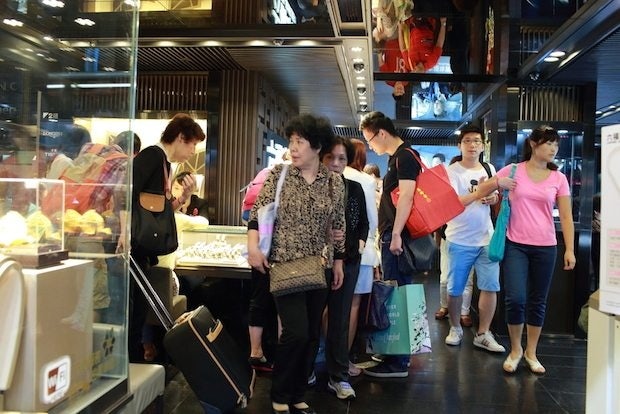
Mainland Chinese shoppers in a Hong Kong jewelry store. (Shutterstock)
Mainland Chinese shoppers in search of avoiding high tariffs on luxury goods are a mainstay for Hong Kong retailers, who are currently panicking as Hong Kong’s government mulls curbs on Chinese visitor numbers. With a growing number of duty-free shopping alternatives for Chinese travelers, Hong Kong may be set to lose out big-time on Chinese tourist spending.
On Tuesday, Hong Kong Secretary for Commerce and Economic Development Gregory So Kam-leung made clear at a press conference that the government is still considering imposing limits to the number of mainland Chinese visitors allowed to enter after the subject was brought up earlier this year in response to an outbreak of anti-mainland sentiment. He stated that among other measures, it is considering capping the number of visits by nearby mainland residents eligible for multiple-entry permits to 52 entries per year.
Retailers that have already been hit by declining Chinese visitor growth in Hong Kong are hoping that the plan won’t be carried out. Hong Kong has been seeing a drop in retail sales every month since February of this year as the growth rate for the number of inbound mainlanders has slid downward. In June, retail sales fell 6.9 percent year-on-year to $4.8 billion. For luxury, jewelry and watches have seen a significant decline in demand, according to Bloomberg.
The growth rate for the number of mainland Chinese visitors to Hong Kong sunk to 7.8 percent year-on-year for the month of June after staying in the double digits during the previous five months of the year. Over the busy Labor Day travel weekend in May, Hong Kong actually saw a 2 percent decrease in the number of mainland arrivals for the first time in nine years. The total year-to-date growth rate for mainland visitors to Hong Kong is 16 percent, which has fallen below 2013’s 12-month total of 16.7 percent. As you can see in the following list, the year-on-year monthly growth rate in Chinese visitor numbers to Hong Kong has been in decline since March:
January: 23.3%
February: 10.4%
March: 20.1%
April: 18.7%
May: 13.1%
June: 7.8%
Many attribute the slowdown to strong anti-mainland sentiment that has boiled over in recent months. Hong Kong residents have cited crowded public transportation, emptied-out grocery stores, and an undersupply of available doctors as reasons for their anger at the influx of mainland travelers. In February, a group of 100 Hong Kongers stormed Hong Kong’s Tsim Sha Tsui luxury shopping district to protest and harass mainland shoppers while using the derogatory term "locusts" to describe them.
Hong Kong’s government needs to find a balance between responding to public sentiment and keeping the region competitive against a growing number of low-tariff luxury shopping options for Chinese travelers. For example, the world’s largest duty-free store is currently under construction in Hainan, while other mainland cities such as Qingdao and Shanghai are hoping for duty-free shopping options in free trade zones.
Nearby Asian destinations are also touting their shopping credentials to mainland customers. South Korea’s duty-free stores have seen a massive increase in Chinese shoppers in recent years, while loosened travel restrictions for Taiwan have prompted a mainland visitor influx. Japan’s low prices thanks to a weak yen have caused it to make a comeback with Chinese visitors after anti-Japan sentiment previously caused their numbers to plunge.
There are other factors at play in slowing Hong Kong retail sales: China’s anti-corruption crackdown, a high bar set by last year’s Chinese gold-buying spree, and China’s slowing GDP growth have all had an effect as well.
The main question is now whether or not Hong Kong’s government will choose policies that affect retail when it comes to dealing with anti-mainland sentiment, or whether it will work to make the city competitive against new shopping destinations vying for Chinese attention in the coming years. “We must take a cautious view on this matter under the current economic circumstances,’’ said So at the Tuesday press conference.“I’m not fixing a deadline to launch these measures and we will maintain close contacts with mainland authorities for the time being,” he added in order to placate retailers.
Those invested in keeping up high mainland visitor numbers clearly have an agenda against any policies curbing them. “There are still a lot of mainland customers coming here,” Ronnie Chan, the owner of property company Hang Lung properties, told Bloomberg. “The problem is whether you welcome them or not. It’s definitely a big factor.”